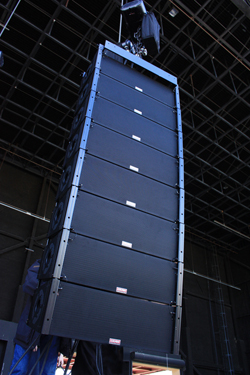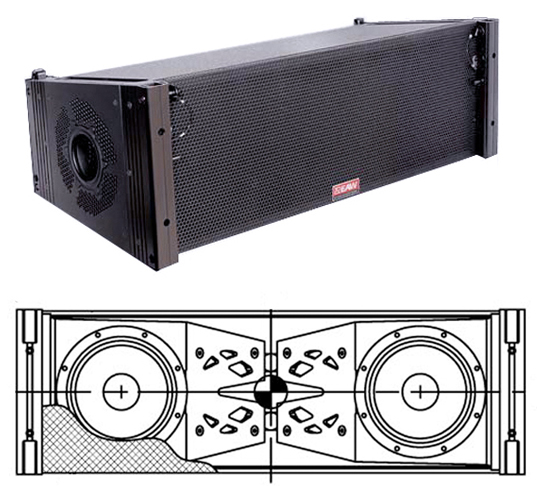Designer Notebook: Inside The Development Of The New EAW KF740 Line Array
The goals and metholodogy behind a new line array.
 EAW KF740 Line Array.
EAW KF740 Line Array.This Designer Notebook was submitted by EAW. Live Sound/ProSoundWeb makes every effort to eliminate any use of marketing-inspired hyperbole.
From the outset of the development process, the new KF740 line array module has been conceived as a medium-sized, flexible package capable of meeting the widest possible range of touring and installation applications, while providing exceptional sound quality as well as efficiency.
Further, it needed to provide full-range performance as a stand-alone line array system as well as be easily integrated into existing KF Series line array structures.
Other primary factors on our list included light weight, fast flyability and convenient cartage - all especially important for portable applications.
We started the design process at a logical point by incorporating the most valuable characteristics of other KF Series modules, led by consistent broadband pattern control, which we view as one of the more critical attributes to the performance of a professional loudspeaker system.
Lack of pattern control inhibits the creation of functional arrays and limits the ability of a loudspeaker to properly cover a given audience area.
However, maintaining it across the frequency range is not an easy task. Proper pattern control requires that the source size is proportional to the wavelength produced by those sources.
In essence, larger wavelengths require larger sources. Horns provide the means to effectively increase the size of a source.
Pattern Control
In 2001, EAW introduced the first completely horn-loaded 3-way line array module, the KF760, with the goal of providing the highest possible degree of pattern control throughout its frequency spectrum.
In 2001, EAW introduced the first completely horn-loaded 3-way line array module, the KF760, with the goal of providing the highest possible degree of pattern control throughout its frequency spectrum.
In fact, the KF760’s front surface is entirely occupied by horns, and this same approach was engineered into a much smaller package, the KF730, which offers 110-degree horizontal dispersion (and 12 degrees vertical).
With the new KF740, a large MF/HF horn also occupies the entire front area of the enclosure to provide control at the lowest range of the mid frequency devices.
Horizontal dispersion is 90 degrees by 12 degrees vertical. HF (1,220 Hz to 20 kHz) is supplied by dual 1.4-inch-exit compression drivers, flanked by dual 8-inch cone drivers delivering MF (255 Hz to 1,373 Hz).

Top: Woofers in the KF740 are arranged in dual phase-aligned pairs, mounted to the sides of the enclosure. Bottom: The horn has an assortment of diamond-shaped openings that minimize the interference presented to the HF.
The desire for extremely tight pattern control was also a focus of the LF design, where response is extended down to 50 Hz.
The KF740 LF section utilizes four 10-inch woofers, in dual phase-aligned pairs, mounted to the sides of the enclosure. Spacing a pair of transducers is much more effective than using a single transducer when pattern control is required at low frequencies.
For example, within its bandwidth in a KF740, an ideal single 10-inch woofer’s response is completely omnidirectional. However, adding a second woofer and spacing it appropriately allows the two woofers to create off-axis cancellation.
This cancellation occurs at the wavelengths that are roughly twice the spacing of the woofers and below the point at which the individual woofers begin to exhibit directivity.
By placing the woofers on the sides as well as the front, the KF740 utilizes the entire width of the enclosure to space the woofers as far apart as possible. This allows the KF740 to maintain pattern control at a lower frequency than that which would otherwise be achieved by only using front-firing woofers in the same size enclosure.
And, the enclosure is sealed so the 10-inch transducers enhance the accurate reproduction that is extremely responsive to any necessary equalization.